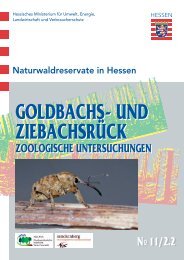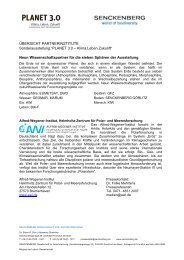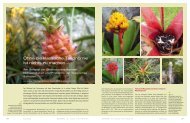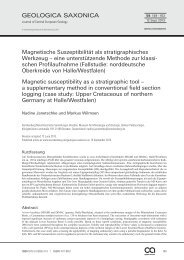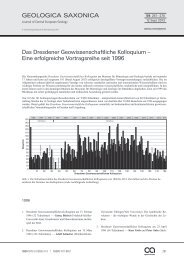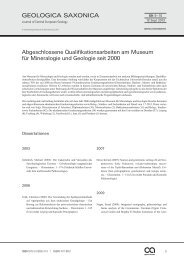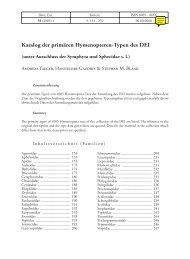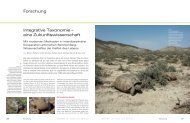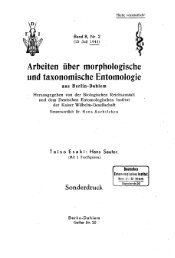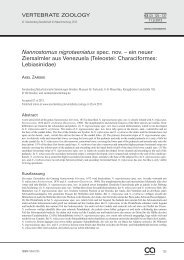Taxonomic publications: past and future - Senckenberg Museum
Taxonomic publications: past and future - Senckenberg Museum
Taxonomic publications: past and future - Senckenberg Museum
You also want an ePaper? Increase the reach of your titles
YUMPU automatically turns print PDFs into web optimized ePapers that Google loves.
Burckhardt & Mühlethaler (eds): 8 th GfBS Annual Conference Abstracts 44<br />
New insights in the evolution of liverworts stimulated by symbiotic fungi<br />
M. Nebel, I. Kottke & M. Preußing<br />
Liverworts are the sister group to all the other l<strong>and</strong>plants (mosses, hornworts, ferns<br />
<strong>and</strong> flowering plants). Liverworts, like algae, lack the specific introns which occur in<br />
all other l<strong>and</strong>plants. A fossil record (spore tetrads) from the Ordovician (460 my)<br />
appeared to belong to basal liverworts.<br />
Several studies on molecular phylogeny of liverworts were published, recently.<br />
Projecting our results of symbiotic fungi in liverworts on these molecular phylogenetic<br />
trees we found the following scenario: Glomeromycota are restricted to basal groups<br />
of liverworts (Haplomitriopsida), complex thalloid Marchantiopsida, <strong>and</strong> the basal<br />
group of the simple thalloid liverworts (Fossombroniales sensu Heinrichs). These<br />
liverworts grow mainly on mineral soil as do the Glomeromycota. Molecular <strong>and</strong> fossil<br />
data support the position of the Glomeromycota as the most ancient terrestrial fungi.<br />
We, therefore, suggest that the symbiosis with Glomeromycota was established in<br />
liverworts, first, long before Rhyniales. Later, the more derived liverworts<br />
(Metzgeriales, Jungermanniales, Porellales sensu Heinrichs) lost the symbiosis with<br />
Glomeromycota, probably at a common event.<br />
New forms of symbiosis were then established, twice <strong>and</strong> independently, by the<br />
phylogenetic younger liverwort groups: at one h<strong>and</strong> by the simple thalloid<br />
Metzgeriales associating with the basidiomycotean genus Tulasnella, at the other<br />
h<strong>and</strong> within the leafy liverworts (Jungermanniales, Porellales) forming symbiosis with<br />
the genus Sebacina (Basidiomycota) <strong>and</strong> the genus Hymenoscyphus (Ascomycota).<br />
Basidio- <strong>and</strong> Ascomycota are phylogenetic younger terrestrial fungi.<br />
Loss of the symbiosis with glomeromycotan fungi was probably connected to a<br />
change of the terrestrial habitat to epiphytism. Likely, at that time, the increase of<br />
angiosperm tree species lead to a fundamental shift in ecosystem conditions. In<br />
denser forests, light on the forest floor was reduced but angiospermean tree bark<br />
improved the conditions for an epiphytic life style. Epiphytism was correlated with the<br />
loss of the soil dependent Glomeromycota.<br />
The new fungal symbionts belonging to the genera Sebacina, Tulasnella, <strong>and</strong><br />
Hymenoscyphus are typical colonizers of rotten wood <strong>and</strong> humus. Thus liverworts<br />
obtained access to new nutrient resources. The symbiosis, thus, pushed the<br />
evolution of new taxa.<br />
If the loss of Glomeromycota <strong>and</strong> the regain of modern terrestrial fungi were the<br />
result of fundamental habitat changes, the symbiotic status can be used as an<br />
indicator for the development of former ecosystems.<br />
Org. Divers. Evol. 5, Electr. Suppl. 13 (2005)




